Related Research Articles

Guanyin is a Bodhisattva associated with compassion. She is the East Asian representation of Avalokiteśvara and has been adopted by other Eastern religions, including Chinese folk religion. She was first given the appellation "Goddess of Mercy" or "Mercy Goddess" by Jesuit missionaries in China. Guanyin is short for Guanshiyin, which means "[The One Who] Perceives the Sounds of the World." On the 19th day of the sixth lunar month, Guanyin's attainment of Buddhahood is celebrated.
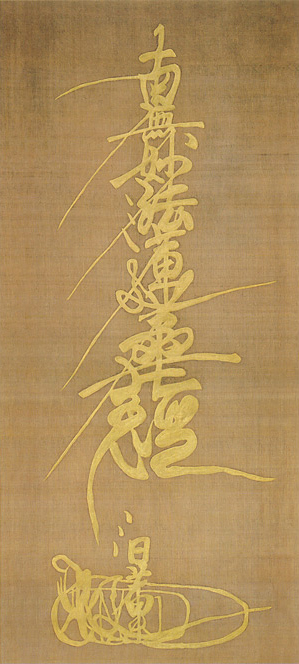
Namu Myōhō Renge Kyō (南無妙法蓮華経) are Japanese words chanted within all forms of Nichiren Buddhism. In English, they mean "Devotion to the Mystic Law of the Lotus Sutra" or "Glory to the Dharma of the Lotus Sutra".
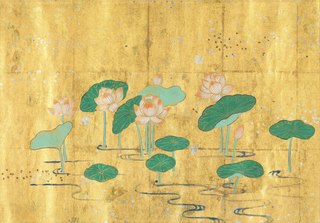
The Lotus Sūtra is one of the most influential and venerated Buddhist Mahāyāna sūtras. It is the main scripture on which the Tiantai, Tendai, Cheontae, and Nichiren schools of Buddhism were established. It is also influential for other East Asian Buddhist schools, such as Zen. According to the British Buddhologist Paul Williams, "For many Buddhists in East Asia since early times, the Lotus Sūtra contains the final teaching of Shakyamuni Buddha—complete and sufficient for salvation." The American Buddhologist Donald S. Lopez Jr. writes that the Lotus Sūtra "is arguably the most famous of all Buddhist texts," presenting "a radical re-vision of both the Buddhist path and of the person of the Buddha."
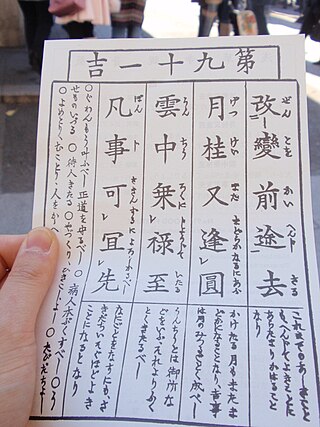
Omikuji (御御籤/御神籤/おみくじ) are random fortunes written on strips of paper at Shinto shrines and Buddhist temples in Japan. Literally "sacred lot", these are usually received by making a small offering and randomly choosing one from a box, hoping for the resulting fortune to be good. As of 2011, vending machines sometimes dispense omikuji.

Hokkekō is the mainstream lay organization affiliated with the Nichiren Shōshū. It traces its origins to three martyr disciples who were arrowed and later beheaded in the Atsuhara persecutions and a more recent tradition of family lineages between 1726 and 1829 who have historically protected the Dai-Gohonzon over the centuries.

Pure Land is the concept of a celestial realm of a buddha or bodhisattva in Mahayana Buddhism where many Buddhists aspire to be reborn in.

Gorintō (五輪塔) is a Japanese type of Buddhist pagoda believed to have been first adopted by the Shingon and Tendai sects during the mid Heian period. It is used for memorial or funerary purposes and is therefore common in Buddhist temples and cemeteries. It is also called gorinsotōba or gorinsotoba (五輪卒塔婆) or goringedatsu (五輪解脱), where the term sotoba is a transliteration of the Sanskrit word stupa. The stupa was originally a structure or other sacred building containing a relic of Buddha or of a saint, then it was gradually stylized in various ways and its shape can change quite a bit according to the era and to the country where it is found. Often offertory strips of wood with five subdivisions and covered with elaborate inscriptions also called sotoba can be found at tombs in Japanese cemeteries. The inscriptions contain sūtra and the posthumous name of the dead person. These can be considered stupa variants.

Yunju Temple is a Buddhist temple located in Fangshan District, 70 kilometers (43 mi) southwest of Beijing and contains the world's largest collection of stone Buddhist sutra steles. Yunju Temple also contains one of only two extant woodblocks for the Chinese Buddhist Tripitaka in the world as well as rare copies of printed and manuscript Chinese Buddhist Tripitakas. It also has many historic pagodas dating from the Tang and Liao Dynasty.
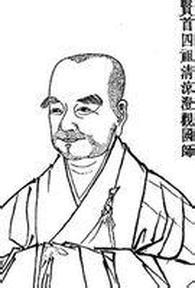
Qingliang Chengguan, was an important scholar-monk and patriarch of the Huayan school of Chinese Buddhism also known as Huayan pusa and Qingliang Guoshi.
This is the discography of Taiwanese Mandopop artist Show Lo. From 1996 to 1998, he was part of a quartet boy band Four Heavenly Kings (四大天王), releasing five albums. Then in 1998, after two members left, he formed a duo Romeo (羅密歐), with Ou Han Sheng ; the other member of Four Heavenly Kings, released two albums and was active till 2000. In 2003, he debuted as a solo artist with the release of Show Time. He has since released eleven Mandarin studio, one Japanese studio, three compilation, one remix and three concert DVD albums.

The Yiqiejing yinyi is the oldest surviving Chinese dictionary of Buddhist technical terminology, and was the archetype for later Chinese bilingual dictionaries. This specialized glossary was compiled by the Tang dynasty lexicographer monk Xuanying (玄應), who was a translator for the famous pilgrim and Sanskritist monk Xuanzang. When Xuanying died he had only finished 25 chapters of the dictionary, but another Tang monk Huilin (慧琳) compiled an enlarged 100-chapter version with the same title, the (807) Yiqiejing yinyi.

The Yiqiejing yinyi 一切經音義 "Pronunciation and Meaning in the Complete Buddhist Canon" was compiled by the Tang dynasty lexicographer monk Huilin 慧琳 as an expanded revision of the original Yiqiejing yinyi compiled by Xuanying 玄應. Collectively, Xuanying's 25-chapter and Huilin's 100-chapter versions constitute the oldest surviving Chinese dictionary of Buddhist technical terminology. A recent history of Chinese lexicography call Huilin's Yiqiejing yinyi "a composite collection of all the glossaries of scripture words and expressions compiled in and before the Tang Dynasty" and "the archetype of the Chinese bilingual dictionary".

Temple of King Ashoka is a Buddhist temple located in Yinzhou District of Ningbo, Zhejiang, China.

Taiwanese entertainer Jolin Tsai has appeared in 187 music videos, 33 video albums, and four video singles. In 1999, she released her first music video of "I Know You're Feeling Blue". In 2000, she released her first concert video, 1019 I Can Concert and her first music video compilation, Don't Stop. In 2001, she released her second concert video, Show Your Love Concert and her second music video compilation, Show Your Love. In 2002, she released her third music video compilation, Lucky Number.

The Ten Rākṣasīs (十羅刹女), sometimes translated as the misnomer ten demon daughters or ten demonesses are a group of rākṣasīs who take on the role of tutelary deities in Mahayana Buddhism.
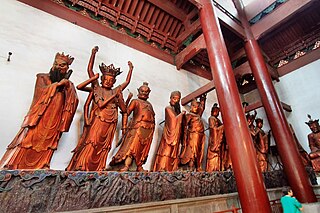
The Twenty-Four Protective Deities or the Twenty-Four Devas, sometimes reduced to the Twenty Protective Deities or the Twenty Devas, are a group of dharmapalas in Chinese Buddhism who are venerated as defenders of the Buddhist dharma. The group consists of devas, naga kings, vajra-holders and other beings, mostly borrowed from Hinduism with some borrowed from Taoism.
References
- Kuboand, Tsugunari; Yuyama, Akira (2007). The Lotus Sutra (PDF). Numata Center for Buddhist Translation and Research.
- The Noble Mahāyāna Sūtra “The Basket’s Display”, translated from Tibetan by Peter Alan Roberts with Tulku Yeshi (CC-BY-NC-ND)
- Cowell, E. B.; Rouse, W. H. D. "Vidhurapaṇḍita Jātaka". Internet Sacred Text Archive. Retrieved 2019-04-27.
- Tagare, G.V. (1958). The Brahmānda Purāna (Part II). Delhi: Motilal Banarsidass Publishers Private Ltd. ISBN 9788120838246.
- "Gandhabbā". Buddhist Dictionary of Pali Proper Names. Retrieved 2019-04-27.
- "Home". Wisdom Library. Retrieved 2019-04-27.